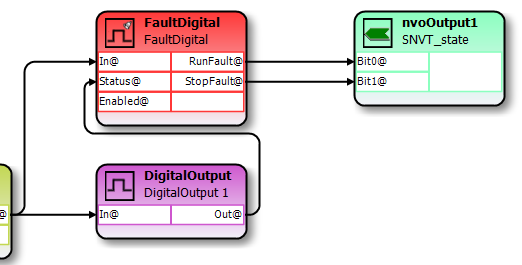The FaultDigital programming block can be used to determine that an overridden output is not following the state commanded by the program. In the example shown in Figure 19, the In slot is linked to the program output, and the Status slot is linked to the digital output controlling the fan. The FaultDigital programming block would detect a Fan override when the In slot value differed from the Status slot value. The FaultDigital programming block would then activate either the RunFault or StopFault output slots as appropriate. In this example, the RunFault and StopFault outputs are used to set the fields on a SNVT_state network variable.
Figure 19: Detecting Fan Override by Using a FaultDigital Programming Block

Input and Output Table for FaultDigital (Enabled input must be True.) |
|||
In |
Status |
RunFault |
StopFault |
T |
T |
F |
F |
T |
F |
T |
F |
F |
T |
F |
T |
F |
F |
F |
F |
Inputs |
||||
|
Slots |
Type |
Default |
Description |
|
In |
Digital |
Null |
The input monitoring the commanded state. The default value is Null. |
|
Status |
Digital |
Null |
The input monitoring the actual state or the feedback status. The default value is Null. |
|
Enabled |
Digital |
True |
Determines if the block is enabled, the default value is True. |
Outputs |
|||
|
Slots |
Type |
Description |
|
RunFault |
Digital |
If enabled, and if the In slot value is True, and the Status slot value is False, the RunFault output is True. (The Delay property determines how long this condition must be present before the RunFault or StopFault is set to True.) |
|
StopFault |
Digital |
If enabled, and if the In slot value is False, and the Status slot value is True, the StopFault output is True. (The Delay property determines how long this condition must be present before the RunFault or StopFault is set to True.) |
Properties |
||
|
Slot |
Description |
|
Delay |
The input must be in Fault condition for this period of time (in seconds) before the output becomes True. |